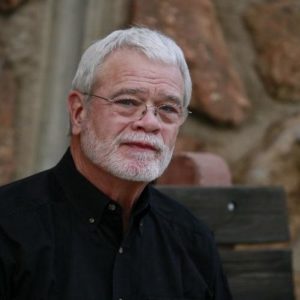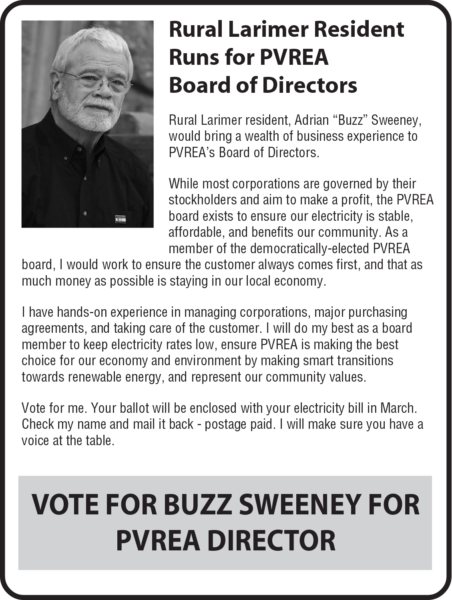

The following is an Editorial article written by Buzz Sweeney published in the North Forty News March 2018 edition.
LIVERMORE, CO – Wrist watches used to have hands. Phones used to have rotary dialers. All cars used to need gasoline and drivers. Taxis used to be yellow. But not anymore. The most economical electrical power used to be generated by huge dams and coal burning plants. But not anymore.
Adrian “Buzz” Sweeney is running for a seat on the Poudre Valley Rural Electrical Association’s (PVREA’s) Board of Directors. He is asking for your support. Your ballot will soon arrive in your mail box. Just check his name and mail it back. Postage paid. Easy. Here is why you may want to vote for Buzz.
Technology is tricky. Think of a loop. Technology creates problems, fixes problems and then creates dilemmas. When it comes to the generation of electricity, we are in the dilemma stage. Circa 1935 federal New Deal legislation resulted in rural electrification. This includes where you and I live. The federal government strung the wires, while distribution co-ops such as the PVREA were formed to maintain that infrastructure. Other co-ops were established to bring power from the western hydroelectric dams. Soon those transmission co-ops built huge regional coal burning power generating facilities. Everyone was happy. The economies of scale benefited everyone. Reasonable laws and contracts protected the suppliers of wholesale electricity, the long-distance transmission companies, the distribution co-ops and finally the consumers, you and me too. Technology and money had solved our “we need electricity” problem.
Jump forward to today. Technology has continued along its own self-directed path of discovery and is presenting you and me with a dilemma. Just like rotary phones have quickly faded from your memory so too will the huge generating plants which currently supply our electricity. They are no longer needed. The drivers of this change are, as before, technology and money. Here is the problem. Why should a rancher buy electricity to mine for water to irrigate their crop and livestock when the technology (wind and solar) is now available to produce more electricity than the rancher needs and have an overage to sell? Or, why should you and I, who need electricity only for our home, car and cell phone, pay more just because our vendor continues to re-sell electricity made with yesterday’s technology? We shouldn’t.

New vocabulary comes with the new technology. “Distributed generation”, also called the “democratization of energy” means, as an example, solar panels will be “distributed” on unused land, and ranchers will erect wind mills on their corn fields. Such distribution will result in “resilience”. Distribution companies like PVREA will need to provide for “intermittent integration” of the rancher’s excess electricity. “Levelized cost of energy” means the true cost of production before considering either positive or negative (tariffs) subsidies. “Microgrids” and “demand-side management programs” mean that distribution co-ops like PVREA need to actively plan for each locale’s two-way usage demands.
Energy subsidies are no longer needed. Clean energy is less expensive and more desirable than dirty energy. There is one function the federal government can do to help consumers namely, maintain its role as the collector and distributor of information describing the evolving disparate renewable energy technologies and renewable business models. The National Renewable Energy Laboratory in Golden CO is presently that resource. Unfortunately, and shortsightedly, its’ budget is presently threatened.
The pending transition from “dirty” to “clean” energy is neither science-fiction nor will its’ implementation be without effort. A Director’s job is to be your voice at the decision table. It is time for Directors to set policies that match today’s technologies. To do less is simply not acceptable.
CONCLUSION
America’s dependence on electricity increases as the population increases. New clean technologies can meet that need without the adverse by-product of carbon dioxide and other greenhouse gases. It is now possible and economically beneficial to produce electricity more locally, transmit it shorter distances and more efficiently. Technology now supports the distribution co-op’s efforts to manage microgrids and to provide the consumer with the lowest possible cost electricity. The three threats to the consumer being able to benefit from new clean energy technologies are the unresolved financial burden of closing coal burning generation plants, secondly the government needs to “catch up” to the public’s desire for clean energy and finally, to stop subsidizing (negatively and positively) all forms of energy.
Adrian “Buzz” Sweeney is a candidate for election in April 2018 to the PVREA’s Board of Directors. Buzz researched this article and gives appropriate credit to Mountain Times News, The Washington Post and to information gleaned from CSU’s 2017 Energy Transition Symposium.
Support Northern Colorado Journalism
Show your support for North Forty News by helping us produce more content. It's a kind and simple gesture that will help us continue to bring more content to you.
BONUS - Donors get a link in their receipt to sign up for our once-per-week instant text messaging alert. Get your e-copy of North Forty News the moment it is released!
Click to Donate